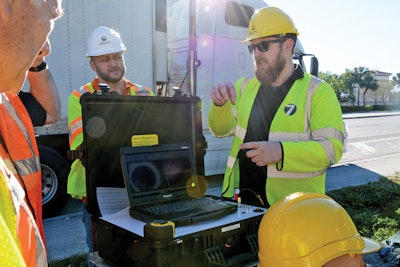City uses inspection platform to prioritize water pipe issues
Problem / The city of Santa Monica, California, needed to inspect and assess pressurized potable water pipes to determine pipe and asset condition on live pressurized pipelines ranging from 4 to 20 inches and then identify and prioritize a list of water mains to be replaced as part of future CIPP projects.
Solution / Using the Investigator platform from Aquam Pipe Diagnostics, a total of 40 pressurized pipe sections were identified by the city, which incorporated various materials, age, diameters and operational pressures. Wet barrel fire hydrants were selected as access points, and inspections encompassed a minimum of 50 feet upstream and downstream of the insertion point. Heavily tuberculated laterals remained a consistent theme throughout the survey and, in fact, proved to be in significantly worse condition than the mainlines.
Result / The city is in the process of reviewing the data from the inspection and intends to redesign its capital improvement plan, prioritize intervention and remediation techniques, and align capital expenditure based on the results and recommendations from the inspection. 858-242-1640; www.aquamcorp.com.
Epoxy coating used on badly deteriorated manholes
Problem / A project in the city of Coquille, Oregon, required the rehabilitation of 15 badly deteriorated, 48-inch manholes located in a flood plain that is largely swampland. Most locations were inaccessible for the delivery and utilization of spray equipment.
Solution / Neopoxy International is the manufacturer of high-strength, corrosion-resistant, sprayable and hand-applied NPR-5300 series epoxy resins, specifically designed for manhole coatings. Per Neopoxy International’s recommendation, Michels used 3-gallon One-Step KITs of trowelable epoxy resin NPR-5305. The kits are easy to use since both parts of the epoxy system are preloaded in the same container. They don’t require spray equipment, instead just an electric drill with a paint blade and a spatula. Using the specified 250-mil thickness, Michels hand-applied the epoxy to around 80 percent of the work area. The remaining area was sprayed with NPR-5304, another Neopoxy International epoxy product, to a thickness of 250 mils.
Result / The epoxy resin was successfully applied by the crew of three on the deteriorated manholes. 510-782-1290; www.neopoxy.us.
Chemical grout system puts a stop to active leaks
Problem / A municipality in Texas was in need of a cost-effective way to stop problematic, high-volume active leaks in their collections system manholes. In-house crews had the capability to do the work with a chemical grout injection system but needed a system that would provide consistent results.
Solution / The crew decided to try Seal-Tite, a two-component, fast-acting chemical grout system from Parson Environmental Products. The team was so impressed, they bought the product in bulk, along with two pneumatic application guns for a solution every time they find a leak.
Result / The municipality has a 100 percent success rate for stopping active leaks. They continue to stock the product in bulk for quick fixes to a problem that used to cause them a lot of headaches. 800-356-9023; www.parsonenvironmental.com.







